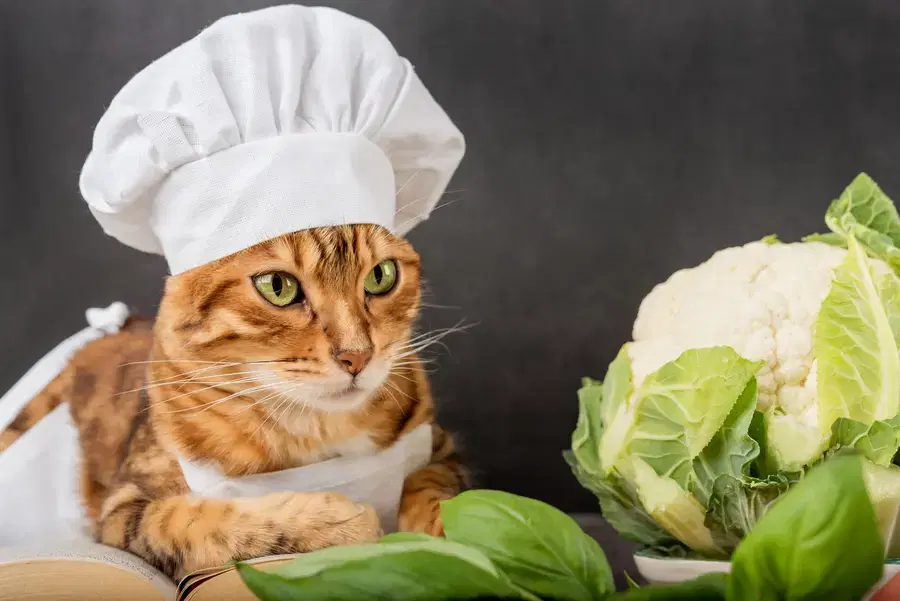Cats are super picky about a lot of things, especially food. But they also can take you by surprise with what they end up liking. We know that what we enjoy for meals shouldn’t always be a cat's food too, but can cats eat cauliflower? Yes, they can!
Rich in antioxidants and high in fiber, cauliflower can be a great veggie for your cat.
But can it be a meal replacement? Read on to know everything about how good cauliflower for your cat’s health is.
Is Cauliflower Safe for Cats?
Yes! Cauliflower is safe for cats. Cauliflower is a rich source of fiber, vitamin B, and antioxidants. All of which helps reduce inflammation in cats. Some cats that are experiencing joint pain may benefit from consuming cauliflower at regular intervals. Cauliflower is also packed with dietary fiber which can improve digestion.
All in all, cauliflower does have some properties that help prevent pain. Isn't that something every cat parent needs for their cat? We obviously wouldn’t recommend you replace your favorite Vet with a basket of veggies, but it’s good to know that some veggies can help your ailing cat.
Risks of Serving Cauliflower to Cats
Cauliflowers are loaded with fiber which is hard for cats to break down while digesting. This can cause serious diarrhea or bloating which brings in extra discomfort to them. Additionally, due to the poor digesting process, your cat is also at risk of being constipated.
Besides this, overfeeding your cats with anything can cause weight gain, and being overweight does bring its share of health problems for your cat.
Should I Feed My Cat More Cauliflower?
Whether or not your cat likes cauliflower will depend on their mood. Some days they might just love it, some days they won’t even sniff it. Either way, never force-feed your cat anything they do not want to try. If you do want to introduce cauliflower to your cat's diet, you need to do so in moderation. You can start with finely chopped, boiled cauliflower but they may also skip their meal as eating some cauliflower florets is quite heavy for their diet.
How Much Cauliflower Is Safe for Cats?
Vegetables of any kind are not the most preferred option in a cat's diet. However, if you must feed them some cauliflower, it should not be over ¼ cup of boiled cauliflower.
Cats may not be familiar with cauliflower’s taste which is why you can start slowly and feed it to them gradually. But always make sure to feed your cat some cooked or boiled cauliflower only. This reduces the fiber content in them and makes it easier for cats to bite on and digest well.
Can I Feed Canned Cauliflower to Cats?
Even if a few chopped-up canned veggies or fruits won’t harm your cat, it is always best to feed them fresh food. Frozen items contain preservatives and artificial colours which are best avoided when it comes to feeding them to your cats. But if you are serving some canned or frozen vegetables, always make sure to thaw them to make it easier for them to chew and bite.
How To Cook Cauliflower for Cats
The best way to feed cauliflower to cats is by properly washing it and adding it to boiling water. Once softened, you can chop and cut them into small bite-sized pieces making it easy for them to chew. Not chopping the veggies into small pieces can cause a choking hazard as well.
Whether you steam, boil, or sauté them in a pan, make sure to not add any seasonings to it. If it's your cat’s first time trying cauliflower, look at how they respond to the first bite before feeding them any more of it.
Here are some ways to feed cauliflower to cats:
Garnish your cat’s meal with cauliflower pieces to make it exciting for them to try.
Offer it as a treat instead of their usual snack the next time you are training your little furry friend.
Grind it to a fine paste and add it to a mashed salmon.
How To Prepare Vegetables for Cat:
Cats are obligatory carnivores which is why it is okay if their diet includes only about 2% of veggies. But if your cat is overweight or has difficulty with digestion, you can replace regular cat treats with cauliflowers. Yes, your cat can eat cauliflower for snacking but always follow safety measures and have a check on snacking in moderation.
Safe Ways to Prepare Vegetables for Cats:
Rinse Your Vegetables Well:
Just like you would rinse fruits and veggies before having them, you should do the same for your cat. Most vegetables contain germs and pesticides that can be a huge irritant for your cat. Ensure to wash, dry, and store your vegetables in a safe environment that doesn’t put your cat's health at stake.
Opt For Steaming Over Frying:
For vegetables that are hard to chop like cauliflower, broccoli, and carrots, you can steam them and mash them up too. This will make it easier for your cat to chew them up and it won’t affect its nutritional value.
Chop Your Vegetables:
Every cat eats at their own pace, but we all know how fast felines can gobble up their meals. If your cat isn’t a slow eater, feeding them cauliflower without chopping them up may cause a choking hazard. Always chop the veggies in small bite sizes or powder them in a food processor.
Conclusion:
If your question is, “Can cats eat cauliflower?” the short answer is, yes! But it is always important to have all the information handy on whether you can feed cauliflower to cats.
While you can feed cauliflower to cats, it is best to do so in moderation. With its fiber, nutrients, and vitamins, it is a good addition to your cat’s diet, but never replace it with meat or cat food.

Creative manager by day, pet enthusiast all the time! After 19 years with my dog (hopefully he wins the award for oldest pet in the world), I enjoy spending my days brainstorming tail-wagging content, and sniffing out the latest trends in the pet world.
*Jan 2019 to Aug 2024 Spot Pet Insurance Services, LLC claims data.
"Can Cats Have Cauliflower?" PetsCare, n.d., https://www.petscare.com/news/post/can-cats-have-cauliflower.
Adams, Christian. "Can Cats Eat Cauliflower?" Catster, 19 Jun. 2025, https://www.catster.com/nutrition/can-cats-eat-cauliflower/.
The information presented in this article is for educational and informational purposes only and does not constitute or substitute for the advice of your veterinarian.












